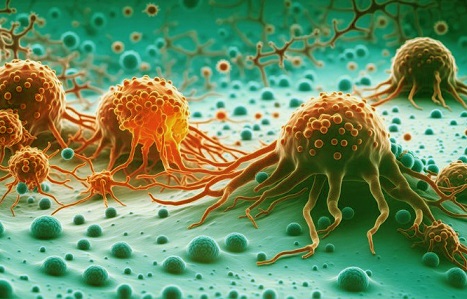Nikhil Prasad Fact checked by:Thailand Medical News Team Nov 04, 2024 5 months, 1 week, 3 days, 17 hours, 35 minutes ago
Medical News: Researchers from Renmin Hospital of Wuhan University uncover a key protein influencing the spread of a dangerous cancer type.
 New Clues to Cancer Growth, SAR1A's Role in Head and Neck Tumors
Understanding Head and Neck Squamous Cell Carcinoma
New Clues to Cancer Growth, SAR1A's Role in Head and Neck Tumors
Understanding Head and Neck Squamous Cell Carcinoma
Head and neck squamous cell carcinoma (HNSCC) ranks among the most common cancers globally, posing significant challenges to patients and medical teams. Despite advancements in treatments like surgery, chemotherapy, and targeted therapies, survival rates hover around 50% over five years, according to recent studies. In the search for new treatments, scientists have been looking closely at the molecular pathways driving HNSCC progression. One protein, SAR1A, has emerged as a significant player in this disease, impacting cell growth and the spread of tumors.
This
Medical News report presents findings from the Department of Otolaryngology-Head and Neck Surgery and the Central Laboratory at Renmin Hospital of Wuhan University. Researchers, including Shizhen Fang, Jie Wang, Tianyi Liu, Yang Jiang, and Qingquan Hua, have published groundbreaking research identifying SAR1A’s role in HNSCC. Their work provides insight into potential future treatments for this aggressive cancer type.
SAR1A: What is It and Why Does It Matter?
SAR1A, part of a family of small proteins involved in cell transport, has been linked to numerous diseases, including cancers. While SAR1A had already been shown to play roles in other cancer types, its specific effects on HNSCC were unknown until this study. The Wuhan University team used a combination of laboratory (in vitro) and animal model (in vivo) experiments to evaluate how SAR1A affects cancer cell growth, migration, and invasion.
Using gene sequencing analysis, researchers identified the PI3K/AKT/mTOR pathway, a molecular pathway crucial to cell growth and survival, as heavily impacted by SAR1A. By knocking down SAR1A (reducing its presence) in cancer cells, they observed reduced cancer cell growth and spread. Additionally, animal models showed that lower SAR1A levels correlated with slower tumor growth and fewer metastases.
How SAR1A Influences Cancer Cells
The researchers found that SAR1A plays a key role in enhancing the aggressiveness of HNSCC cells by impacting the epithelial–mesenchymal transition (EMT) process. EMT is a biological transformation that makes cancer cells more mobile and invasive, helping them spread to other parts of the body. In cells with high SAR1A, markers associated with EMT were significantly elevated, suggesting SAR1A’s role in promoting a more aggressive cancer type.
In the lab, SAR1A knockdown led to a reduction in several cancer behaviors:
-Lowered cell growth: Cancer cells with decreased SAR1A showed reduced viability and slower rates of division.
-Reduced invasion and migration: Knocked-down SAR1A levels sign
ificantly reduced the cancer cells' ability to invade and migrate.
-Suppressed EMT markers: EMT-related proteins like N-cadherin, Snail, and Vimentin were less active when SAR1A levels were reduced, marking a decrease in aggressive tumor behavior.
The team also discovered that when SAR1A was reintroduced or overexpressed in cells where it was previously knocked down, these aggressive behaviors returned, underscoring SAR1A’s importance in cancer growth.
Uncovering the Role of PI3K/AKT/mTOR Pathway
Further analysis revealed SAR1A’s effect on the PI3K/AKT/mTOR pathway, known for its role in many types of cancer. The PI3K/AKT/mTOR pathway is vital for cell survival, proliferation, and metabolism. When SAR1A levels were high, this pathway was overactive, driving cancer growth. However, when SAR1A was reduced, researchers noted a decrease in the activity of the pathway, corresponding to a reduction in cancer spread.
To confirm the connection between SAR1A and this pathway, the researchers introduced LY294002, a drug that inhibits the PI3K/AKT pathway. With this drug, they observed a marked reduction in the aggressive behaviors of SAR1A-overexpressing cells. This experiment highlighted how SAR1A influences HNSCC through PI3K/AKT/mTOR, offering a potential drug target to counteract SAR1A’s impact on cancer.
Implications for Future Treatments
The study’s results suggest that SAR1A could serve as a valuable biomarker to predict disease progression in HNSCC patients. The protein’s significant impact on cell growth and metastasis could help identify patients at higher risk for aggressive disease and offer new targets for drug development.
In addition, inhibiting SAR1A may improve responses to current treatments. Combining SAR1A inhibitors with traditional therapies like radiation or chemotherapy might help prevent the spread of HNSCC, especially in advanced stages. Given the protein’s involvement in EMT and PI3K/AKT/mTOR pathways, therapies targeting these areas could reduce the likelihood of recurrence or metastasis.
Conclusions
This research from Renmin Hospital of Wuhan University adds to the growing evidence of SAR1A’s role in HNSCC. The findings open new doors for cancer treatment strategies by:
-Confirming SAR1A as a prognostic biomarker for HNSCC.
-Highlighting the PI3K/AKT/mTOR pathway as a critical target in managing SAR1A-driven cancer growth.
-Providing insights into how drug interventions, like LY294002, can suppress SAR1A’s effects, potentially reducing tumor aggressiveness.
SAR1A’s role in cell migration, invasion, and the EMT process in HNSCC offers a promising target for developing future therapies. These findings could lead to more precise and effective treatments, especially for patients with advanced or high-risk HNSCC, ultimately improving survival rates and quality of life.
The study findings were published in the peer-reviewed journal: Biomedicines.
https://www.mdpi.com/2227-9059/12/11/2477
For the latest Cancer News, keep logging into Thailand
Medical News.
Read Also:
https://www.thailandmedical.news/news/amino-acid-deprivation-as-a-new-hope-in-glioblastoma-treatment
https://www.thailandmedical.news/news/thailand-medical-researchers-explore-potential-anti-cancer-power-of-acacia-concinna
https://www.thailandmedical.news/news/protein-crotonylation-and-its-connection-to-cancer
